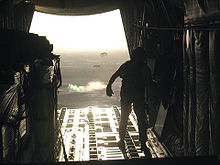| Operation Medusa | |||||||
|---|---|---|---|---|---|---|---|
| Part of the War in Afghanistan (2001–2021) | |||||||
 A Canadian C–130 drops containerized delivery system bundles in support of Operation Medusa | |||||||
| |||||||
| Belligerents | |||||||
|
|
| ||||||
| Strength | |||||||
| 2,000 | 1,200+ | ||||||
| Casualties and losses | |||||||
| Total: 31 killed |
512 killed 136 captured[1] | ||||||
Operation Medusa (September 2–17, 2006) was a Canadian-led offensive during the second Battle of Panjwaii of the War in Afghanistan. The operation was fought primarily by the 1st Battalion, The Royal Canadian Regiment Battle Group and other elements of the International Security Assistance Force, including A Co, 2-4 Infantry BN, 4th BDE, 10th Mtn Division, supported by the Afghan National Army and a team from the United States Army's 1st Battalion, 3rd Special Forces Group (Airborne) augmented by C Company, 2nd Battalion, 87th Infantry Regiment of the 10th Mountain Division. Its goal was to establish government control over an area of Kandahar Province centered in the district of Panjwayi some 30 kilometres (19 mi) west of Kandahar city. A tactical victory, it resulted in the deaths of 12 Canadian soldiers; five during the major combat operations, five in bombings, and two in a mortar/RPG attack during the reconstruction phase of the operation. Fourteen British military personnel were also killed when their plane crashed. Despite suffering a brutal battlefield defeat, the Taliban retained their presence in Kandahar province, leading to the subsequent Operation Falcon Summit. Nonetheless, Operation Medusa was at the time the most significant land battle ever undertaken by NATO.[2]